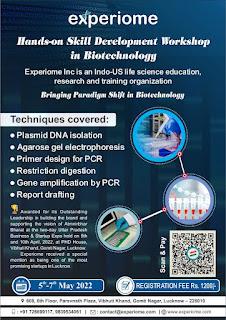Ethics and Requirements of Plant Tissue Culture Laboratory | Experiome Inc
Ethics and Requirements of Plant Tissue Culture Laboratory
Plant tissue culture generally refers
to in vitro culture of all plant parts
under sterile conditions. Basic facilities are must in the laboratory where
tissue culture technology is to be performed. This includes general cleaning
and media preparation, sterilization, storage, sterile transfer, observation /
data acquisition, and environmentally controlled incubator or culture room
areas. The most important work area is the Cultural Transfer Office, where core activities take place. Plant tissue
culture should be cultured for a specified period of time under well-controlled
temperature, humidity, airflow, and light quality. Plant culture techniques
require a variety of organic and inorganic chemicals to prepare the culture medium. The growing room is an equally
important area where plant cultures are maintained under controlled
environmental conditions for optimal growth. After in vitro culture of plants
they are transferred to the pots. The potted plants are immediately transferred
to the greenhouse or growth cabinets and are maintained under proper conditions
of light, temperature, and humidity. Research and training organization
Facilities in tissue culture labs are:
•
Area for general washing, media
preparation, sterilization, and storage
•
Aseptic transfer area
•
Incubators and culture rooms
•
Lab should be free from dust, smoke,
molds, spores, and chemicals.
•
Plant pathology lab should be far from the
laboratory.
Washing area:
Large sinks should be there in the lab
including draining boards, racks, dryers, automated dishwashers, storage
cabinets, and access to demineralized water, distilled water, and
double-distilled water. Guidelines for the washing area:
•
Glassware should be washed and dried out
after the use without allowing Media or agar to dry.
•
Glassware with corrosive chemicals should
be separated from rest of the glassware and contaminated glassware should be
autoclaved before washing.
•
Immediately after completion of an
experiment the contents of containers should be discarded.
Requirements of media preparation in the
room:
•
Refrigerator/freezer and high quality
water
•
Hot plate/stirrer, pH meter, balances,
vacuum pump
•
Double-distillation assembly and autoclave
•
Equipment like dissecting microscopes,
microwave, water baths, laboratory washers, ovens, automatic media (dispensers
are helpful when pipetting large volumes of media) should be there
•
Bunsen burners.
•
Type 2 reagent grade water should be used
for preparation of the media. Type 2 water is free from pyrogens, gases, and
organic matter, and has electrical conductivity less than 1.0 umho/cm
Culture room
In culture room light, temperature, and
humidity are maintained and are varied according to the size of the room. Plant
cultures are kept in the growth room under controlled environmental conditions
to achieve optimal growth. Temperature (temperature should be constant
throughout the culture room, i.e., no hot or cold spots; 13 and 30°C, with a
temperature fluctuation of less than 0.3°C; always with a temperature alert
alarm system to monitor temperature fluctuations), humidity (range of 20–98
percent controllable to 3%, air circulation), and light quality (fluorescent
lighting to reach 10,000 lu) are all important factors to consider when
incubating tissue cultures. For a 24-hour period, both light and temperature
should be programmable. Protoplast cultures, low-density cell suspension
cultures, and anther cultures are especially sensitive to cultural conditions
in the environment. Plant cultures can also be shifted to another room if one
room's cooling or lighting fails. This prevents cultures from being lost. To avoid
contamination, the number of doors in the growth chamber should be kept to a
minimum. Except when natural light is employed, there is no need for windows in
the growth room. External light can interfere with the photoperiod and
temperature of the growth room when artificial lighting is employed. The
culture containers can be put on either fixed or mobile shelves, depending on
the quantity of available space and cost. Mobile shelves have the benefit of
allowing access to cultures on both sides of the shelf. The shelf height should
not exceed 2 metres. To place and retrieve cultures from high shelving, step-up
stools are required, which can be unsafe and time consuming. The lights
positioned on the shelves are usually the dominant source of illumination in the
growth chamber. Overhead light sources can be reduced because they will only be
used during the dark cycle. The traditional downward illumination may not
provide homogeneous light to plant cultures. Uneven heat distribution is caused
by lights that are directly attached to the racks. This results in a high level
of humidity within the culture containers, which might lead to hyperhydricity.
Sideways illumination is an option that uses fewer lights and produces more
uniform lighting. The following are some of the most important needs for a
culture room.
Laminar Air Flow
A laminar flow hood is another form of
transfer area. A dust filter forces air into the unit, which is then passed
through a HEPA filter. After that, the air is directed either downward (vertical
flow unit) or outward (horizontal flow unit) across the working surface.
Nonfiltered air and particle matter do not settle on the working surface
because of the steady flow of bacteria-free filtered air.
Safety rules in the lab:
•
In the lab eating, smoking, and drinking
are strictly prohibited.
•
Toxic chemicals should be discarded with
properly with precautions.
•
First aid kits and fire extinguishers
should be equipped in the labs.
• It is necessary to use autoclaved Pipettes, tips, Pasteur pipettes, and other items in the lab to prevent contamination.
Visit Here-Biotechnology Training in Lucknow

Comments
Post a Comment